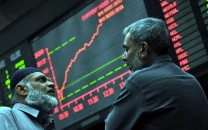Point of concern: Has our banking system become unsound?
Non-performing loans of banks have more than doubled since 2006.

Point of concern: Has our banking system become unsound?
Pakistan’s financial sector liberalisation in general and privatisation of banks in particular has largely been hailed by experts on account of professionalisation, financial inclusion and penetration of banks. Notwithstanding the usual criticism of a high interest spread and high bank charges, strong evidences have now emerged which suggest that the banking sector has become visibly unsound.
Since 2009, the State Bank of Pakistan has maintained ‘financial soundness indicators’ of the banking system. These parameters include capital adequacy, assets quality, earnings and liquidity. The most recently released “Statistics of the Banking System” actually erodes the goodwill that has been associated with a liberalised banking industry.
The most startling fact is that the exposure of all banks to non-performing loans has more than doubled since 2006. The stock of NPLs in public sector commercial banks has increased from 9% to 21%, in foreign banks from 1% to 10.5% and in commercial banks from 5.7% to 15.5%. In the case of public sector commercial banks, the ratio of net NPLs to their capital is 44%, which was 6.4% in 2006, whereas this is 23.8% in commercial banks, up from 6.2% in 2006.
In nutshell, the assets of banks have become significantly more toxic. The bad quality toxic assets of the banking sector were the single most important symptom, though not the cause, of the great financial depression, the world witnessed recently.
The increasing exposure to NPLs has dampened the profitability of banks as well. Overall, the earnings before tax, when measured by returns on assets, have decreased by 24% over the last six years. Certainly, this reduction is much more pronounced in public sector commercial banks as it has come down from 4% in 2006 to 1.9% in 2012. Return on equity before tax has been reduced from 35.2% to 26.3% in the same time period.
Another disturbing indicator is the increasing cost of operations as measured by cost-income ratio. For public sector commercial banks, this was 31.8% in 2006, which now stands at a staggering 57.9% in 2012. For foreign banks, this has jumped from 49.8% to 69.3%.
Despite these developments, the liquidity in banks has increased from 31.9% to 44%. But at the same time, the advances-deposit ratio has decreased from 74.6% to 54.3%. It means that the banks are preferring to keep the cash to their tills.
The moral of the story
The banking system is becoming more unsound, less profitable, more expensive, more liquid and more toxic. Has the mantra of deregulation, denationalisation and privatisation failed?
My hypothesis is that the banks of all categories have been increasingly swamped with demands of risk-free lending from the government, drying up of genuine business projects and a general risk aversion amongst the bankers. Banks of all creeds share a similar fortune to varying degree now.
According to the State Bank, the top five banks, which hold 51% of total banking assets and 50.9% of total investments, have parked 82.2% of their investments in government securities. The foreign banks have parked 99.9% of their investments in government securities. This trend is common across the entire banking system. Now imagine that the federal government is ‘slightly’ less credible. Who will repay all this investment with such quality of governance?
That the return to an NPL-dominated regime, which was characteristic of nationalised banks, will only feed into risk aversion of bankers should not be a surprise. However, unlike the political pressures which were usually held culprit for these loans in the nationalisation era, the deregulated banks should bear the brunt themselves now. It means that the owners, directors and majority shareholders should be held responsible to this extent. If a bank fails on this ground, the state must stay away, and unlike what the Western governments did, must not socialise the costs of default. Although insurance of small deposits can be a viable consideration.
It is true that the bankers alone cannot be held responsible for uninterrupted demand of risk-free loans and a shocking absence of business projects of scale. Probably, the non-availability of business projects can be explained by poor, expensive and unreliable energy infrastructure. For the risk-free loans, the political ambitions of the government, always devoid of any economic wisdom, will be held responsible.
It is evidently clear that increased government borrowing not only sucks up available capital, but also induces risk aversion among bankers, and at the same time, makes it prohibitively expensive for the private sector to borrow.
The writer is managing partner of Development Pool – an economic research organisation – and is a founding member of Economic Freedom Network Pakistan
Published in The Express Tribune, July 23rd, 2012.



















COMMENTS
Comments are moderated and generally will be posted if they are on-topic and not abusive.
For more information, please see our Comments FAQ